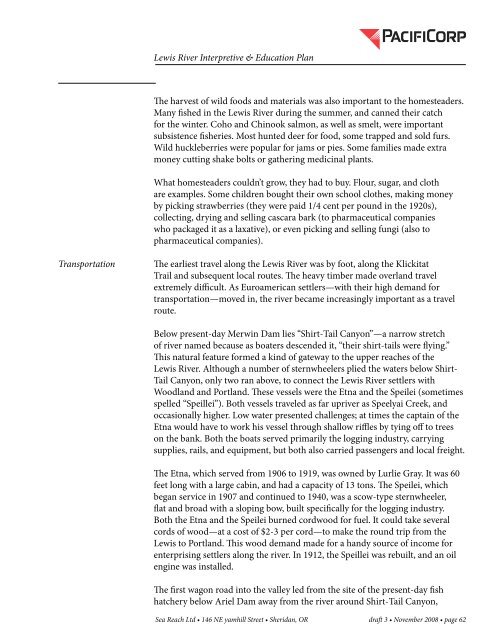The Lewis River Hydroelectric Projects - PacifiCorp
The Lewis River Hydroelectric Projects - PacifiCorp
The Lewis River Hydroelectric Projects - PacifiCorp
You also want an ePaper? Increase the reach of your titles
YUMPU automatically turns print PDFs into web optimized ePapers that Google loves.
<strong>Lewis</strong> <strong>River</strong> Interpretive & Education Plan<br />
<strong>The</strong> harvest of wild foods and materials was also important to the homesteaders.<br />
Many fished in the <strong>Lewis</strong> <strong>River</strong> during the summer, and canned their catch<br />
for the winter. Coho and Chinook salmon, as well as smelt, were important<br />
subsistence fisheries. Most hunted deer for food, some trapped and sold furs.<br />
Wild huckleberries were popular for jams or pies. Some families made extra<br />
money cutting shake bolts or gathering medicinal plants.<br />
What homesteaders couldn’t grow, they had to buy. Flour, sugar, and cloth<br />
are examples. Some children bought their own school clothes, making money<br />
by picking strawberries (they were paid 1/4 cent per pound in the 1920s),<br />
collecting, drying and selling cascara bark (to pharmaceutical companies<br />
who packaged it as a laxative), or even picking and selling fungi (also to<br />
pharmaceutical companies).<br />
Transportation<br />
<strong>The</strong> earliest travel along the <strong>Lewis</strong> <strong>River</strong> was by foot, along the Klickitat<br />
Trail and subsequent local routes. <strong>The</strong> heavy timber made overland travel<br />
extremely difficult. As Euroamerican settlers—with their high demand for<br />
transportation—moved in, the river became increasingly important as a travel<br />
route.<br />
Below present-day Merwin Dam lies “Shirt-Tail Canyon”—a narrow stretch<br />
of river named because as boaters descended it, “their shirt-tails were flying.”<br />
This natural feature formed a kind of gateway to the upper reaches of the<br />
<strong>Lewis</strong> <strong>River</strong>. Although a number of sternwheelers plied the waters below Shirt-<br />
Tail Canyon, only two ran above, to connect the <strong>Lewis</strong> <strong>River</strong> settlers with<br />
Woodland and Portland. <strong>The</strong>se vessels were the Etna and the Speilei (sometimes<br />
spelled “Speillei”). Both vessels traveled as far upriver as Speelyai Creek, and<br />
occasionally higher. Low water presented challenges; at times the captain of the<br />
Etna would have to work his vessel through shallow riffles by tying off to trees<br />
on the bank. Both the boats served primarily the logging industry, carrying<br />
supplies, rails, and equipment, but both also carried passengers and local freight.<br />
<strong>The</strong> Etna, which served from 1906 to 1919, was owned by Lurlie Gray. It was 60<br />
feet long with a large cabin, and had a capacity of 13 tons. <strong>The</strong> Speilei, which<br />
began service in 1907 and continued to 1940, was a scow-type sternwheeler,<br />
flat and broad with a sloping bow, built specifically for the logging industry.<br />
Both the Etna and the Speilei burned cordwood for fuel. It could take several<br />
cords of wood—at a cost of $2-3 per cord—to make the round trip from the<br />
<strong>Lewis</strong> to Portland. This wood demand made for a handy source of income for<br />
enterprising settlers along the river. In 1912, the Speillei was rebuilt, and an oil<br />
engine was installed.<br />
<strong>The</strong> first wagon road into the valley led from the site of the present-day fish<br />
hatchery below Ariel Dam away from the river around Shirt-Tail Canyon,<br />
Sea Reach Ltd • 146 NE yamhill Street • Sheridan, OR draft 3 • November 2008 • page 62
















